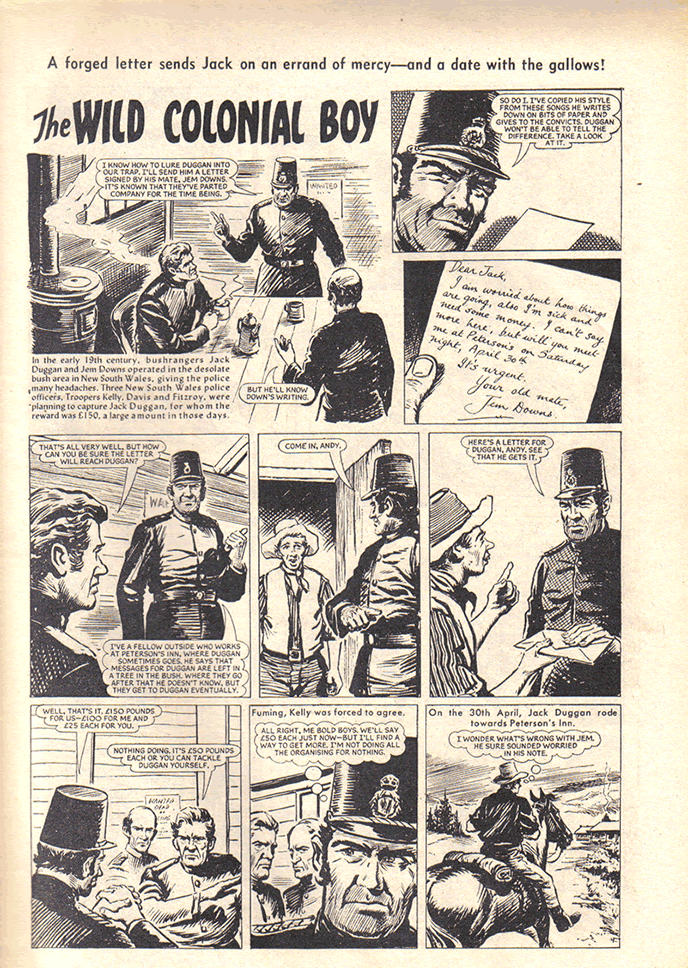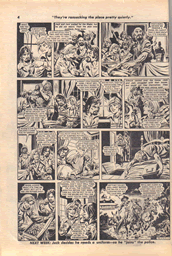

Writer:-Not known. Artists:- First version - Frederick Alan Philpott; Second version - Matias Alonso.
Main cast:- Jack Duggan, the Wild Colonial Boy; Jem Downs.
Time period:-Late 19th Century Australia.
The Wild Colonial Boy strip has appeared twice in The Victor and is loosely based on the ballard of the same name which is well known in Australia. The first strip was drawn by Frank Philpotts, whilst the second (using the same script, but with some minor changes), was drawn by the Spanish artist Matias Alonso. Images one and two below show an example of each artists artwork using the same page of script. For information on both of these artists please visit the Artist Identify page
. |
 |
The Colonial Boy Jack Duggan, is a Robin Hood type character, in that he robs from the rich and gives to the poor. The ballard only gives the barest of details regarding the Colonial Boy’s background and his exploits. In The Victor’s version Duggan has been convicted for the stealing of a loaf of bread and sent by prison ship to serve his term in Australia. Duggan, along with other prisoners manage to take control of the prison ship briefly before being recaptured. Once in New South Wales, the young Duggan (who has been flogged a couple of times), is sent to serve his prison term at a timber gang. It’s there that he meets his fellow highwayman Jem Downs. Eventually, Duggan escapes and joins up with a group of murderous bushrangers led by Darcy. But soon finds that they are just as happy to kill as they are to steal. Duggan doesn’t agree with his fellow bushrangers that they have to kill in order to rob the rich. After Darcy has been killed after a disastrous highway robbery (in which Duggan shoots and kills Judge McAvoy, who also appears in the ballard). The Colonial Boy becomes leader of the gang.
Although it is a short lived experience for him, as the gang members turn against him. It is then that he meets Jem Downs and his life proper as a highwayman begins.
Eventually though after many adventures Duggan and Downs are captured and sent to the prison on Pinchgut Island. They escape and rescue two of the Govenors men and as a result he is pardoned at the end of the series.
The ballard in full is reproduced below. There is no indication in the ballard of what happens to The Colonial Boy once he has been captured, presumably he would have been shot, sent to jail or escaped.
THE WILD COLONIAL BOY – the ballard by Anonymous
'Tis of a wild Colonial Boy, Jack Doolan was his name, Of poor but honest parents he was born in Castlemaine. He was his father's only hope, his mother's pride and joy, And dearly did his parents love the wild Colonial Boy.
Chorus:-
Come, all my hearties, we'll roam the mountains high, Together we will plunder, together we will die. We'll wander over valleys, and gallop over plains, And we'll scorn to live in slavery, bound down with iron chains.
He was scarcely sixteen years of age when he left his father's home, And through Australia's sunny clime a bushranger did roam. He robbed those wealthy squatters, their stock he did destroy, And a terror to Australia was the wild Colonial Boy.
In sixty-one this daring youth commenced his wild career, With a heart that knew no danger, no foeman did he fear. He stuck up the Beechworth mail-coach, and robbed Judge MacEvoy, Who trembled, and gave up his gold to the wild Colonial Boy.
He bade the judge "Good morning", and told him to beware, That he'd never rob a hearty chap that acted on the square, And never to rob a mother of her son and only joy, Or else you might turn outlaw, like the wild Colonial Boy.
One day as he was riding the mountain-side along, A-listening to the little birds, their pleasant laughing song, Three mounted troopers rode along - Kelly, Davis and FitzRoy - They thought that they would capture him, the wild Colonial Boy.
"Surrender now, Jack Doolan, you see there's three to one. Surrender now, Jack Doolan, you're a daring highwayman." He drew a pistol from his belt, and shook the little toy, "I'll fight, but not surrender," said the wild Colonial Boy.
He fired at Trooper Kelly and brought him to the ground, And in return from Davis received a mortal wound. All shattered through the jaws he lay still firing at FitzRoy, And that's the way they captured him - the wild Colonial Boy.
a) As far as I can ascertain, there is no record in Australia of a bushranger named Jack Duggan or Jem Downs. There was though a bushranger called Jack Donahue.
b) Beechworth was a major gold mining town last century, please see the photograph.
c) There was a Judge named MacEvoy.
d) There is another Australian Bush Ballard titled "Bold Jack Donahue".
A brief biography of John Donahoe
John Donahoe was born in Ireland in 1804 and transported to Australia for life in 1824 for 'intent to commit a felony'. He was soon in trouble and absconded into the bush with two other bushrangers. They began robbing and thieving before being captured and sentenced to death.
Donahoe (also known as 'Bold Jack') escaped and over the next few years created mayhem in the area of the Hunter Valley. In 1830 a party of soldiers and mounted police caught up with the gang near Campbell Town. In the ensuing struggle Bold Jack was shot in the head by Trooper Michael Muggleston of the 39th Regiment (later the Dorset's).
With the death of Bold Jack his name passed into legend, and a song was sung about him and his exploits. The authorities regarded it as being seditious and it was banned. The names were changed and gradually it developed into the well known Australian folk song The Wild Colonial Boy.
The photograph below is a recent view of Beechworth, Victoria, Australia.
 |
Below is a complete episode from The Colonial Boy for your enjoyment from issue 878.
 |
 |
 |
© Adrian Banfield, 2008.
 |
 |